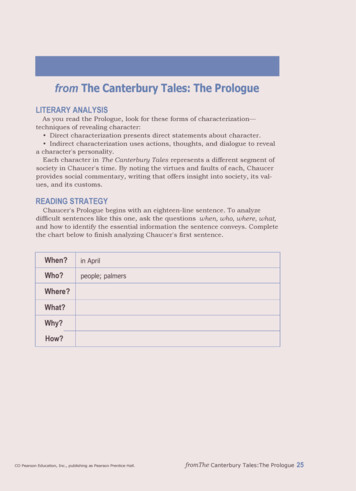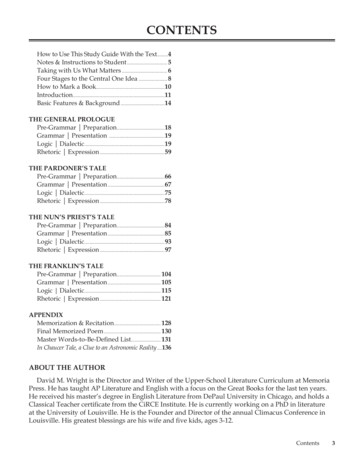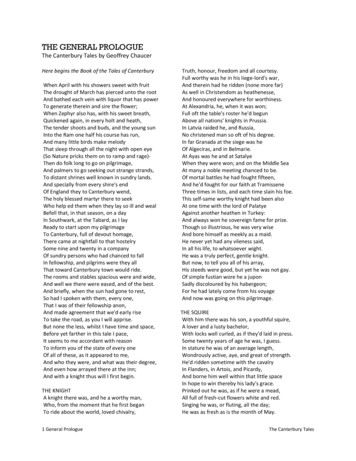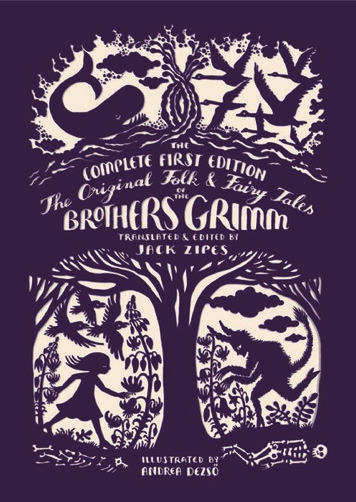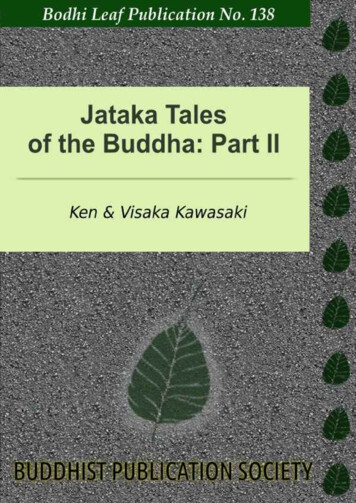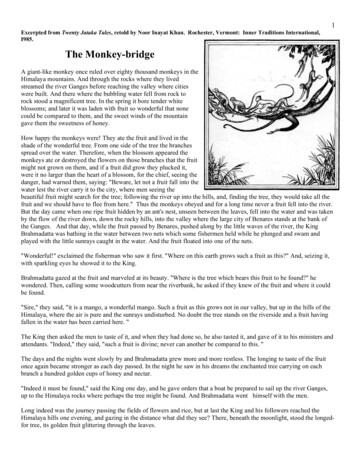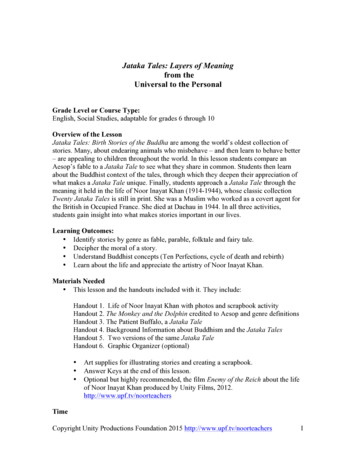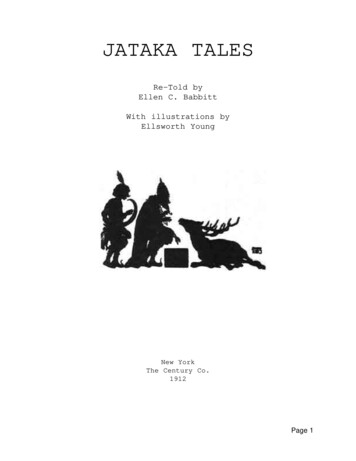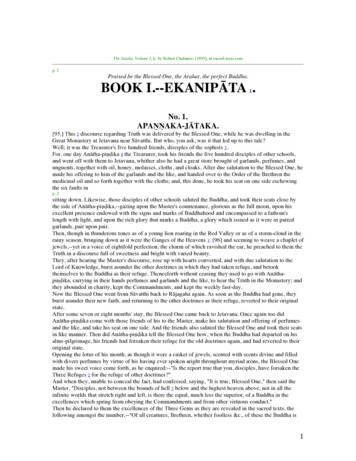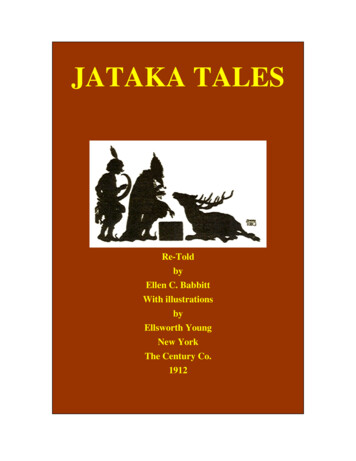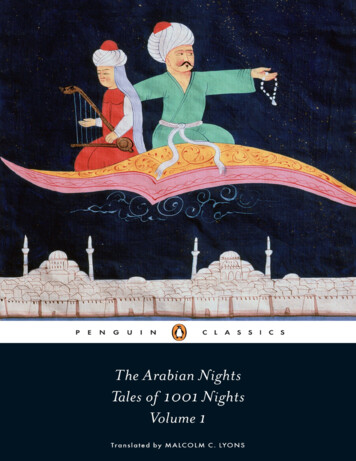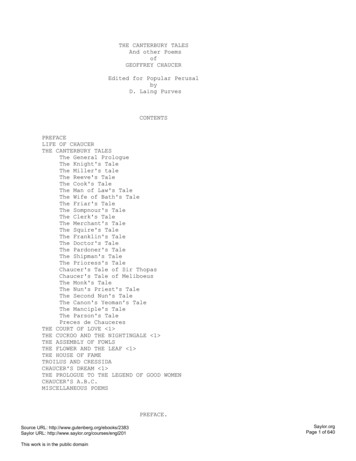
Transcription
THE CANTERBURY TALESAnd other PoemsofGEOFFREY CHAUCEREdited for Popular PerusalbyD. Laing PurvesCONTENTSPREFACELIFE OF CHAUCERTHE CANTERBURY TALESThe General PrologueThe Knight's TaleThe Miller's taleThe Reeve's TaleThe Cook's TaleThe Man of Law's TaleThe Wife of Bath's TaleThe Friar's TaleThe Sompnour's TaleThe Clerk's TaleThe Merchant's TaleThe Squire's TaleThe Franklin's TaleThe Doctor's TaleThe Pardoner's TaleThe Shipman's TaleThe Prioress's TaleChaucer's Tale of Sir ThopasChaucer's Tale of MeliboeusThe Monk's TaleThe Nun's Priest's TaleThe Second Nun's TaleThe Canon's Yeoman's TaleThe Manciple's TaleThe Parson's TalePreces de ChauceresTHE COURT OF LOVE 1 THE CUCKOO AND THE NIGHTINGALE 1 THE ASSEMBLY OF FOWLSTHE FLOWER AND THE LEAF 1 THE HOUSE OF FAMETROILUS AND CRESSIDACHAUCER'S DREAM 1 THE PROLOGUE TO THE LEGEND OF GOOD WOMENCHAUCER'S A.B.C.MISCELLANEOUS POEMSPREFACE.Source URL: http://www.gutenberg.org/ebooks/2383Saylor URL: http://www.saylor.org/courses/engl201This work is in the public domainSaylor.orgPage 1 of 640
THE object of this volume is to place before the general readerour two early poetic masterpieces -- The Canterbury Tales andThe Faerie Queen; to do so in a way that will render their"popular perusal" easy in a time of little leisure and unboundedtemptations to intellectual languor; and, on the same conditions,to present a liberal and fairly representative selection from theless important and familiar poems of Chaucer and Spenser.There is, it may be said at the outset, peculiar advantage andpropriety in placing the two poets side by side in the mannernow attempted for the first time. Although two centuries dividethem, yet Spenser is the direct and really the immediatesuccessor to the poetical inheritance of Chaucer. Those twohundred years, eventful as they were, produced no poet at allworthy to take up the mantle that fell from Chaucer's shoulders;and Spenser does not need his affected archaisms, nor hisfrequent and reverent appeals to "Dan Geffrey," to vindicate forhimself a place very close to his great predecessor in the literaryhistory of England. If Chaucer is the "Well of Englishundefiled," Spenser is the broad and stately river that yet holdsthe tenure of its very life from the fountain far away in otherand ruder scenes.The Canterbury Tales, so far as they are in verse, have beenprinted without any abridgement or designed change in thesense. But the two Tales in prose -- Chaucer's Tale ofMeliboeus, and the Parson's long Sermon on Penitence -- havebeen contracted, so as to exclude thirty pages of unattractiveprose, and to admit the same amount of interesting andcharacteristic poetry. The gaps thus made in the prose Tales,however, are supplied by careful outlines of the omitted matter,so that the reader need be at no loss to comprehend the wholescope and sequence of the original. With The Faerie Queen abolder course has been pursued. The great obstacle to thepopularity of Spencer's splendid work has lain less in itslanguage than in its length. If we add together the three greatpoems of antiquity -- the twenty-four books of the Iliad, thetwenty-four books of the Odyssey, and the twelve books of theAeneid -- we get at the dimensions of only one-half of TheFaerie Queen. The six books, and the fragment of a seventh,which alone exist of the author's contemplated twelve, numberabout 35,000 verses; the sixty books of Homer and Virgilnumber no more than 37,000. The mere bulk of the poem, then,has opposed a formidable barrier to its popularity; to saynothing of the distracting effect produced by the numberlessepisodes, the tedious narrations, and the constant repetitions,which have largely swelled that bulk. In this volume the poemis compressed into two-thirds of its original space, through theexpedient of representing the less interesting and moremechanical passages by a condensed prose outline, in which ithas been sought as far as possible to preserve the very words ofthe poet. While deprecating a too critical judgement on thebare and constrained precis standing in such tryingjuxtaposition, it is hoped that the labour bestowed in saving thereader the trouble of wading through much that is not essentialfor the enjoyment of Spencer's marvellous allegory, will not beSource URL: http://www.gutenberg.org/ebooks/2383Saylor URL: http://www.saylor.org/courses/engl201This work is in the public domainSaylor.orgPage 2 of 640
unappreciated.As regards the manner in which the text of the two great works,especially of The Canterbury Tales, is presented, the Editor isaware that some whose judgement is weighty will differ fromhim. This volume has been prepared "for popular perusal;" andits very raison d'etre would have failed, if the ancientorthography had been retained. It has often been affirmed byeditors of Chaucer in the old forms of the language, that a littletrouble at first would render the antiquated spelling andobsolete inflections a continual source, not of difficulty, but ofactual delight, for the reader coming to the study of Chaucerwithout any preliminary acquaintance with the English of hisday -- or of his copyists' days. Despite this complacentassurance, the obvious fact is, that Chaucer in the old forms hasnot become popular, in the true sense of the word; he is not"understanded of the vulgar." In this volume, therefore, the textof Chaucer has been presented in nineteenth-century garb. Butthere has been not the slightest attempt to "modernise"Chaucer, in the wider meaning of the phrase; to replace hiswords by words which he did not use; or, following the exampleof some operators, to translate him into English of the modernspirit as well as the modern forms. So far from that, in everycase where the old spelling or form seemed essential to metre,to rhyme, or meaning, no change has been attempted. But,wherever its preservation was not essential, the spelling of themonkish transcribers -- for the most ardent purist must nowdespair of getting at the spelling of Chaucer himself -- has beendiscarded for that of the reader's own day. It is a poorcompliment to the Father of English Poetry, to say that by suchtreatment the bouquet and individuality of his works must belost. If his masterpiece is valuable for one thing more than anyother, it is the vivid distinctness with which English men andwomen of the fourteenth century are there painted, for the studyof all the centuries to follow. But we wantonly balk the artist'sown purpose, and discredit his labour, when we keep before hispicture the screen of dust and cobwebs which, for the Englishpeople in these days, the crude forms of the infant languagehave practically become. Shakespeare has not suffered bysimilar changes; Spencer has not suffered; it would be surprisingif Chaucer should suffer, when the loss of popularcomprehension and favour in his case are necessarily all thegreater for his remoteness from our day. In a much smallerdegree -- since previous labours in the same direction had leftfar less to do -- the same work has been performed for thespelling of Spenser; and the whole endeavour in this departmentof the Editor's task has been, to present a text plain and easilyintelligible to the modern reader, without any injustice to the oldpoet. It would be presumptuous to believe that in every caseboth ends have been achieved together; but the laudatorestemporis acti - the students who may differ most from the planpursued in this volume -- will best appreciate the difficulty ofthe enterprise, and most leniently regard any failure in thedetails of its accomplishment.With all the works of Chaucer, outside The Canterbury Tales, itwould have been absolutely impossible to deal within the scopeSource URL: http://www.gutenberg.org/ebooks/2383Saylor URL: http://www.saylor.org/courses/engl201This work is in the public domainSaylor.orgPage 3 of 640
of this volume. But nearly one hundred pages, have beendevoted to his minor poems; and, by dint of careful selectionand judicious abridgement -- a connecting outline of the story inall such cases being given -- the Editor ventures to hope that hehas presented fair and acceptable specimens of Chaucer'sworkmanship in all styles. The preparation of this part of thevolume has been a laborious task; no similar attempt on thesame scale has been made; and, while here also the truth of thetext in matters essential has been in nowise sacrificed to mereease of perusal, the general reader will find opened up for him anew view of Chaucer and his works. Before a perusal of thesehundred pages, will melt away for ever the lingering tradition orprejudice that Chaucer was only, or characteristically, a coarsebuffoon, who pandered to a base and licentious appetite bypainting and exaggerating the lowest vices of his time. In theseselections -- made without a thought of taking only what is tothe poet's credit from a wide range of poems in which hardly aword is to his discredit -- we behold Chaucer as he was; acourtier, a gallant, pure-hearted gentleman, a scholar, aphilosopher, a poet of gay and vivid fancy, playing aroundthemes of chivalric convention, of deep human interest, orbroad-sighted satire. In The Canterbury Tales, we see, notChaucer, but Chaucer's times and neighbours; the artist has losthimself in his work. To show him honestly and without disguise,as he lived his own life and sung his own songs at the brilliantCourt of Edward III, is to do his memory a moral justice farmore material than any wrong that can ever come out ofspelling. As to the minor poems of Spenser, which follow TheFaerie Queen, the choice has been governed by the desire togive at once the most interesting, and the most characteristic ofthe poet's several styles; and, save in the case of the Sonnets,the poems so selected are given entire. It is manifest that theendeavours to adapt this volume for popular use, have beenalready noticed, would imperfectly succeed without the aid ofnotes and glossary, to explain allusions that have becomeobsolete, or antiquated words which it was necessary to retain.An endeavour has been made to render each page selfexplanatory, by placing on it all the glossarial and illustrativenotes required for its elucidation, or -- to avoid repetitions thatwould have occupied space -- the references to the spot whereinformation may be found. The great advantage of such a planto the reader, is the measure of its difficulty for the editor. Itpermits much more flexibility in the choice of glossarialexplanations or equivalents; it saves the distracting and timeconsuming reference to the end or the beginning of the book;but, at the same time, it largely enhances the liability to error.The Editor is conscious that in the 12,000 or 13,000 notes, aswell as in the innumerable minute points of spelling,accentuation, and rhythm, he must now and again be foundtripping; he can only ask any reader who may detect all that hecould himself point out as being amiss, to set off againstinevitable mistakes and misjudgements, the conscientious labourbestowed on the book, and the broad consideration of its fitnessfor the object contemplated.From books the Editor has derived valuable help; as from MrCowden Clarke's revised modern text of The Canterbury Tales,Source URL: http://www.gutenberg.org/ebooks/2383Saylor URL: http://www.saylor.org/courses/engl201This work is in the public domainSaylor.orgPage 4 of 640
published in Mr Nimmo's Library Edition of the English Poets;from Mr Wright's scholarly edition of the same work; from theindispensable Tyrwhitt; from Mr Bell's edition of Chaucer'sPoem; from Professor Craik's "Spenser and his Poetry,"published twenty-five years ago by Charles Knight; and frommany others. In the abridgement of the Faerie Queen, the planmay at first sight seem to be modelled on the lines of Mr Craik'spainstaking condensation; but the coincidences are eitherinevitable or involuntary. Many of the notes, especially of thoseexplaining classical references and those attached to the minorpoems of Chaucer, have been prepared specially for this edition.The Editor leaves his task with the hope that his attempt toremove artificial obstacles to the popularity of England'searliest poets, will not altogether miscarry.D. LAING PURVES.LIFE OF GEOFFREY CHAUCER.NOT in point of genius only, but even in point of time, Chaucermay claim the proud designation of "first" English poet. Hewrote "The Court of Love" in 1345, and "The Romaunt of theRose," if not also "Troilus and Cressida," probably within thenext decade: the dates usually assigned to the poems ofLaurence Minot extend from 1335 to 1355, while "The Visionof Piers Plowman" mentions events that occurred in 1360 and1362 -- before which date Chaucer had certainly written "TheAssembly of Fowls" and his "Dream." But, though they werehis contemporaries, neither Minot nor Langland (if Langlandwas the author of the Vision) at all approached Chaucer in thefinish, the force, or the universal interest of their works and thepoems of earlier writer; as Layamon and the author of the"Ormulum," are less English than Anglo-Saxon or AngloNorman. Those poems reflected the perplexed struggle forsupremacy between the two grand elements of our language,which marked the twelfth and thirteenth centuries; a struggleintimately associated with the political relations between theconquering Normans and the subjugated Anglo-Saxons.Chaucer found two branches of the language; that spoken bythe people, Teutonic in its genius and its forms; that spoken bythe learned and the noble, based on the French Yet each branchhad begun to borrow of the other -- just as nobles and peoplehad been taught to recognise that each needed the other in thewars and the social tasks of the time; and Chaucer, a scholar, acourtier, a man conversant with all orders of society, butaccustomed to speak, think, and write in the words of thehighest, by his comprehensive genius cast into the simmeringmould a magical amalgamant which made the two half-hostileelements unite and interpenetrate each other. Before Chaucerwrote, there were two tongues in England, keeping alive thefeuds and resentments of cruel centuries; when he laid down hispen, there was practically but one speech -- there was, and eversince has been, but one people.Source URL: http://www.gutenberg.org/ebooks/2383Saylor URL: http://www.saylor.org/courses/engl201This work is in the public domainSaylor.orgPage 5 of 640
Geoffrey Chaucer, according to the most trustworthy traditionsfor authentic testimonies on the subject are wanting -- was bornin 1328; and London is generally believed to have been hisbirth-place. It is true that Leland, the biographer of England'sfirst great poet who lived nearest to his time, not merely speaksof Chaucer as having been born many years later than the datenow assigned, but mentions Berkshire or Oxfordshire as thescene of his birth. So great uncertainty have some felt on thelatter score, that elaborate parallels have been drawn betweenChaucer, and Homer -- for whose birthplace several citiescontended, and whose descent was traced to the demigods.Leland may seem to have had fair opportunities of getting at thetruth about Chaucer's birth -- for Henry VIII had him, at thesuppression of the monasteries throughout England, to searchfor records of public interest the archives of the religioushouses. But it may be questioned whether he was likely to findmany authentic particulars regarding the personal history of thepoet in the quarters which he explored; and Leland's testimonyseems to be set aside by Chaucer's own evidence as to hisbirthplace, and by the contemporary references which make himout an aged man for years preceding the accepted date of hisdeath. In one of his prose works, "The Testament of Love," thepoet speaks of himself in terms that strongly confirm the claimof London to the honour of giving him birth; for he therementions "the city of London, that is to me so dear and sweet,in which I was forth growen; and more kindly love," says he,"have I to that place than to any other in earth; as every kindlycreature hath full appetite to that place of his kindly engendrure,and to will rest and peace in that place to abide." This tolerablydirect evidence is supported -- so far as it can be at such aninterval of time -- by the learned Camden; in his Annals ofQueen Elizabeth, he describes Spencer, who was certainly bornin London, as being a fellow-citizen of Chaucer's -- "EdmundusSpenserus, patria Londinensis, Musis adeo arridentibus natus, utomnes Anglicos superioris aevi poetas, ne Chaucero quidemconcive excepto, superaret." 1 The records of the time noticemore than one person of the name of Chaucer, who heldhonourable positions about the Court; and though we cannotdistinctly trace the poet's relationship with any of thesenamesakes or antecessors, we find excellent ground for beliefthat his family or friends stood well at Court, in the ease withwhich Chaucer made his way there, and in his subsequentcareer.Like his great successor, Spencer, it was the fortune of Chaucerto live under a splendid, chivalrous, and high-spirited reign.1328 was the second year of Edward III; and, what with Scotchwars, French expeditions, and the strenuous and costly struggleto hold England in a worthy place among the States of Europe,there was sufficient bustle, bold achievement, and high ambitionin the period to inspire a poet who was prepared to catch thespirit of the day. It was an age of elaborate courtesy, of highpaced gallantry, of courageous venture, of noble disdain formean tranquillity; and Chaucer, on the whole a man of peacefulavocations, was penetrated to the depth of his consciousnesswith the lofty and lovely civil side of that brilliant and restlessmilitary period. No record of his youthful years, however,Source URL: http://www.gutenberg.org/ebooks/2383Saylor URL: http://www.saylor.org/courses/engl201This work is in the public domainSaylor.orgPage 6 of 640
remains to us; if we believe that at the age of eighteen he was astudent of Cambridge, it is only on the strength of a reference inhis "Court of Love", where the narrator is made to say that hisname is Philogenet, "of Cambridge clerk;" while he had alreadytold us that when he was stirred to seek the Court of Cupid hewas "at eighteen year of age." According to Leland, however,he was educated at Oxford, proceeding thence to France andthe Netherlands, to finish his studies; but there remains nocertain evidence of his having belonged to either University. Atthe same time, it is not doubted that his family was of goodcondition; and, whether or not we accept the assertion that hisfather held the rank of knighthood -- rejecting the hypothesesthat make him a merchant, or a vintner "at the corner of KirtonLane" -- it is plain, from Chaucer's whole career, that he hadintroductions to public life, and recommendations to courtlyfavour, wholly independent of his genius. We have the clearesttestimony that his mental training was of wide range andthorough excellence, altogether rare for a mere courtier in thosedays: his poems attest his intimate acquaintance with thedivinity, the philosophy, and the scholarship of his time, andshow him to have had the sciences, as then developed andtaught, "at his fingers' ends." Another proof of Chaucer's goodbirth and fortune would he found in the statement that, after hisUniversity career was completed, he entered the Inner Temple - the expenses of which could be borne only by men of nobleand opulent families; but although there is a story that he wasonce fined two shillings for thrashing a Franciscan friar in FleetStreet, we have no direct authority for believing that the poetdevoted himself to the uncongenial study of the law. No specialdisplay of knowledge on that subject appears in his works; yetin the sketch of the Manciple, in the Prologue to the CanterburyTales, may be found indications of his familiarity with theinternal economy of the Inns of Court; while numerous legalphrases and references hint that his comprehensive informationwas not at fault on legal matters. Leland says that he quitted theUniversity "a ready logician, a smooth rhetorician, a pleasantpoet, a grave philosopher, an ingenious mathematician, and aholy divine;" and by all accounts, when Geoffrey Chaucercomes before us authentically for the first time, at the age ofthirty-one, he was possessed of knowledge andaccomplishments far beyond the common standard of his day.Chaucer at this period possessed also other qualities fitted torecommend him to favour in a Court like that of Edward III.Urry describes him, on the authority of a portrait, as being then"of a fair beautiful complexion, his lips red and full, his size of ajust medium, and his port and air graceful and majestic. So,"continues the ardent biographer, -- "so that every ornament thatcould claim the approbation of the great and fair, his abilities torecord the valour of the one, and celebrate the beauty of theother, and his wit and gentle behaviour to converse with both,conspired to make him a complete courtier." If we believe thathis "Court of Love" had received such publicity as the literarymedia of the time allowed in the somewhat narrow and selectliterary world -- not to speak of "Troilus and Cressida," which,as Lydgate mentions it first among Chaucer's works, some havesupposed to be a youthful production -- we find a third and notSource URL: http://www.gutenberg.org/ebooks/2383Saylor URL: http://www.saylor.org/courses/engl201This work is in the public domainSaylor.orgPage 7 of 640
less powerful recommendation to the favour of the great cooperating with his learning and his gallant bearing. Elsewhere 2 reasons have been shown for doubt whether "Troilus andCressida" should not be assigned to a later period of Chaucer'slife; but very little is positively known about the dates andsequence of his various works. In the year 1386, being called aswitness with regard to a contest on a point of heraldry betweenLord Scrope and Sir Robert Grosvenor, Chaucer deposed thathe entered on his military career in 1359. In that year EdwardIII invaded France, for the third time, in pursuit of his claim tothe French crown; and we may fancy that, in describing theembarkation of the knights in "Chaucer's Dream", the poetgained some of the vividness and stir of his picture from hisrecollections of the embarkation of the splendid and wellappointed royal host at Sandwich, on board the eleven hundredtransports provided for the enterprise. In this expedition thelaurels of Poitiers were flung on the ground; after vainlyattempting Rheims and Paris, Edward was constrained, by cruelweather and lack of provisions, to retreat toward his ships; thefury of the elements made the retreat more disastrous than anoverthrow in pitched battle; horses and men perished bythousands, or fell into the hands of the pursuing French.Chaucer, who had been made prisoner at the siege of Retters,was among the captives in the possession of France when thetreaty of Bretigny -- the "great peace" -- was concluded, inMay, 1360. Returning to England, as we may suppose, at thepeace, the poet, ere long, fell into another and a pleasantercaptivity; for his marriage is generally believed to have takenplace shortly after his release from foreign durance. He hadalready gained the personal friendship and favour of John ofGaunt, Duke of Lancaster, the King's son; the Duke, while Earlof Richmond, had courted, and won to wife after a certaindelay, Blanche, daughter and co-heiress of Henry Duke ofLancaster; and Chaucer is by some believed to have written"The Assembly of Fowls" to celebrate the wooing, as he wrote"Chaucer's Dream" to celebrate the wedding, of his patron. Themarriage took place in 1359, the year of Chaucer's expedition toFrance; and as, in "The Assembly of Fowls," the formel orfemale eagle, who is supposed to represent the Lady Blanche,begs that her choice of a mate may be deferred for a year, 1358and 1359 have been assigned as the respective dates of the twopoems already mentioned. In the "Dream," Chaucerprominently introduces his own lady-love, to whom, after thehappy union of his patron with the Lady Blanche, he is weddedamid great rejoicing; and various expressions in the same poemshow that not only was the poet high in favour with theillustrious pair, but that his future wife had also peculiar claimson their regard. She was the younger daughter of Sir PayneRoet, a native of Hainault, who had, like many of hiscountrymen, been attracted to England by the example andpatronage of Queen Philippa. The favourite attendant on theLady Blanche was her elder sister Katherine: subsequentlymarried to Sir Hugh Swynford, a gentleman of Lincolnshire;and destined, after the death of Blanche, to be in successiongoverness of her children, mistress of John of Gaunt, andlawfully-wedded Duchess of Lancaster. It is quite sufficientproof that Chaucer's position at Court was of no meanSource URL: http://www.gutenberg.org/ebooks/2383Saylor URL: http://www.saylor.org/courses/engl201This work is in the public domainSaylor.orgPage 8 of 640
consequence, to find that his wife, the sister of the futureDuchess of Lancaster, was one of the royal maids of honour,and even, as Sir Harris Nicolas conjectures, a god-daughter ofthe Queen -- for her name also was Philippa.Between 1359, when the poet himself testifies that he was madeprisoner while bearing arms in France, and September 1366,when Queen Philippa granted to her former maid of honour, bythe name of Philippa Chaucer, a yearly pension of ten marks, orL6, 13s. 4d., we have no authentic mention of Chaucer, expressor indirect. It is plain from this grant that the poet's marriagewith Sir Payne Roet's daughter was not celebrated later than1366; the probability is, that it closely followed his return fromthe wars. In 1367, Edward III. settled upon Chaucer a lifepension of twenty marks, "for the good service which ourbeloved Valet -- 'dilectus Valettus noster' -- Geoffrey Chaucerhas rendered, and will render in time to come." Camdenexplains 'Valettus hospitii' to signify a Gentleman of the PrivyChamber; Selden says that the designation was bestowed "uponyoung heirs designed to he knighted, or young gentlemen ofgreat descent and quality." Whatever the strict meaning of theword, it is plain that the poet's position was honourable andnear to the King's person, and also that his worldlycircumstances were easy, if not affluent -- for it need not be saidthat twenty marks in those days represented twelve or twentytimes the sum in these. It is believed that he found powerfulpatronage, not merely from the Duke of Lancaster and his wife,but from Margaret Countess of Pembroke, the King's daughter.To her Chaucer is supposed to have addressed the "GoodlyBallad", in which the lady is celebrated under the image of thedaisy; her he is by some understood to have represented underthe title of Queen Alcestis, in the "Court of Love" and thePrologue to "The Legend of Good Women;" and in her praisewe may read his charming descriptions and eulogies of the daisy-- French, "Marguerite," the name of his Royal patroness. Tothis period of Chaucer's career we may probably attribute theelegant and courtly, if somewhat conventional, poems of "TheFlower and the Leaf," "The Cuckoo and the Nightingale," &c."The Lady Margaret," says Urry, ". . . would frequentlycompliment him upon his poems. But this is not to be meant ofhis Canterbury Tales, they being written in the latter part of hislife, when the courtier and the fine gentleman gave way to solidsense and plain descriptions. In his love-pieces he was obligedto have the strictest regard to modesty and decency; the ladiesat that time insisting so much upon the nicest punctilios ofhonour, that it was highly criminal to depreciate their sex, or doanything that might offend virtue." Chaucer, in their estimation,had sinned against the dignity and honour of womankind by histranslation of the French "Roman de la Rose," and by his"Troilus and Cressida" -- assuming it to have been among hisless mature works; and to atone for those offences the LadyMargaret (though other and older accounts say that it was thefirst Queen of Richard II., Anne of Bohemia), prescribed to himthe task of writing "The Legend of Good Women" (seeintroductory note to that poem). About this period, too, wemay place the composition of Chaucer's A. B. C., or The Prayerof Our Lady, made at the request of the Duchess Blanche, aSource URL: http://www.gutenberg.org/ebooks/2383Saylor URL: http://www.saylor.org/courses/engl201This work is in the public domainSaylor.orgPage 9 of 640
lady of great devoutness in her private life. She died in 1369;and Chaucer, as he had allegorised her wooing, celebrated hermarriage, and aided her devotions, now lamented her death, in apoem entitled "The Book of the Duchess; or, the Death ofBlanche. 3 In 1370, Chaucer was employed on the King's service abroad;and in November 1372, by the title of "Scutifer noster" -- ourEsquire or Shield-bearer -- he was associated with "JacobusPronan," and "Johannes de Mari civis Januensis," in a royalcommission, bestowing full powers to treat with the Duke ofGenoa, his Council, and State. The object of the embassy wasto negotiate upon the choice of an English port at which theGenoese might form a commercial establishment; and Chaucer,having quitted England in December, visited Genoa andFlorence, and returned to England before the end of November1373 -- for on that day he drew his pension from the Exchequerin person. The most interesting point connected with this Italianmission is the question, whether Chaucer visited Petrarch atPadua. That he did, is unhesitatingly affirmed by the oldbiographers; but the authentic notices of Chaucer during theyears 1372-1373, as shown by the researches of Sir HarrisNicolas, are confined to the facts already stated; and we are leftto answer the question by the probabilities of the case, and bythe aid of what
The Canterbury Tales, so far as they are in verse, have been . printed without any abridgement or designed change in the . sense. But the two Tales in prose -- Chaucer's Tale of . Meliboeus, and the Parson's long
